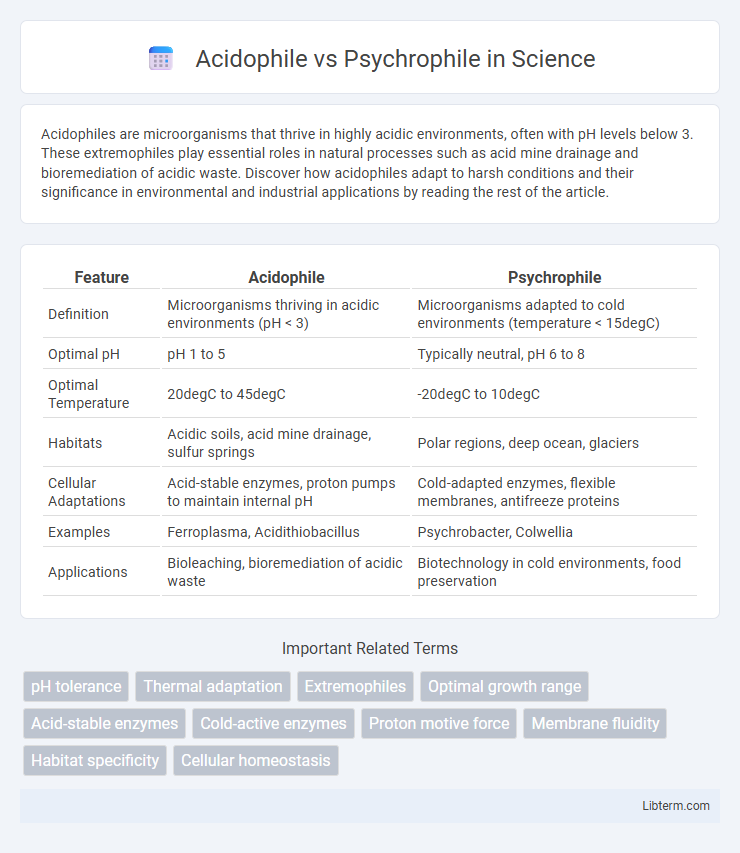Acidophiles are microorganisms that thrive in highly acidic environments, often with pH levels below 3. These extremophiles play essential roles in natural processes such as acid mine drainage and bioremediation of acidic waste. Discover how acidophiles adapt to harsh conditions and their significance in environmental and industrial applications by reading the rest of the article.
Table of Comparison
| Feature | Acidophile | Psychrophile |
|---|---|---|
| Definition | Microorganisms thriving in acidic environments (pH < 3) | Microorganisms adapted to cold environments (temperature < 15degC) |
| Optimal pH | pH 1 to 5 | Typically neutral, pH 6 to 8 |
| Optimal Temperature | 20degC to 45degC | -20degC to 10degC |
| Habitats | Acidic soils, acid mine drainage, sulfur springs | Polar regions, deep ocean, glaciers |
| Cellular Adaptations | Acid-stable enzymes, proton pumps to maintain internal pH | Cold-adapted enzymes, flexible membranes, antifreeze proteins |
| Examples | Ferroplasma, Acidithiobacillus | Psychrobacter, Colwellia |
| Applications | Bioleaching, bioremediation of acidic waste | Biotechnology in cold environments, food preservation |
Introduction to Acidophiles and Psychrophiles
Acidophiles are microorganisms that thrive in highly acidic environments with optimal growth at pH levels below 3, commonly found in acidic hot springs and sulfuric environments. Psychrophiles prefer cold climates, flourishing at temperatures below 15degC, often inhabiting polar regions and deep ocean waters. Both extremophiles have unique adaptations enabling survival under extreme pH or temperature conditions, making them important for biotechnological and ecological studies.
Defining Acidophiles: Key Characteristics
Acidophiles are microorganisms that thrive in highly acidic environments with pH levels typically below 3, exhibiting specialized adaptations such as acid-stable enzymes and membrane structures to maintain intracellular pH homeostasis. These extremophiles are commonly found in sulfur-rich hot springs, acidic mine drainages, and acidic soils, playing essential roles in bioleaching and bioremediation processes. Acidophiles differ from psychrophiles, which prefer cold, low-temperature habitats, highlighting their unique biochemical and ecological niches.
Understanding Psychrophiles: Unique Features
Psychrophiles are microorganisms that thrive in extremely cold environments, typically below 15degC, with optimal growth around 10degC or lower, distinguishing them from acidophiles that prefer acidic conditions. These cold-adapted organisms have unique cellular adaptations, such as flexible enzymes and altered membrane lipid compositions, enabling metabolic activity and growth in subzero temperatures found in polar regions and deep oceans. Understanding psychrophiles contributes to biotechnological applications like cold-active enzymes for industrial processes and insights into Earth's extreme ecosystems.
Environmental Habitats of Acidophiles
Acidophiles thrive in highly acidic environments such as sulfuric hot springs, acid mine drainages, and acidic soils with a pH below 3, where they play a key role in biogeochemical cycles like sulfur and iron oxidation. In contrast, psychrophiles inhabit consistently cold environments including polar regions, glaciers, and deep ocean waters, where temperatures remain below 15degC. The extreme acidity in acidophile habitats challenges cellular processes, requiring specialized adaptations like acid-stable enzymes and membrane structures.
Environmental Adaptations of Psychrophiles
Psychrophiles thrive in extremely cold environments, such as Arctic and Antarctic regions, by producing antifreeze proteins and maintaining flexible cell membranes to prevent ice crystal formation. Their enzymes remain active at low temperatures by having increased structural flexibility, enabling metabolism and growth in temperatures often below 15degC. Unlike acidophiles that adapt to low pH, psychrophiles are specialized for survival through molecular and cellular mechanisms that counteract cold-induced cellular damage.
Molecular Mechanisms for Extreme Survival
Acidophiles maintain proton homeostasis through specialized membrane transporters like proton pumps and antiporters that regulate intracellular pH under highly acidic conditions. Psychrophiles produce antifreeze proteins and flexible enzymes with increased structural disorder, enabling catalytic activity and membrane fluidity at subzero temperatures. Both extremophiles utilize DNA repair systems and chaperone proteins to stabilize cellular components against environmental stress, ensuring molecular integrity and survival.
Industrial and Biotechnological Applications
Acidophiles thrive in highly acidic environments and are crucial in bioleaching for metal recovery, especially in copper and gold mining industries. Psychrophiles, adapted to cold environments, enable biotechnological applications by producing cold-active enzymes used in food processing, bioremediation of polar regions, and molecular biology reagents. Both extremophiles offer valuable enzymes and metabolic pathways that enhance industrial processes under harsh conditions, increasing efficiency and sustainability.
Ecological Importance and Roles
Acidophiles, thriving in highly acidic environments such as acid mine drainages and sulfuric springs, play a crucial role in biogeochemical cycling by oxidizing sulfur and iron, which contributes to nutrient availability and metal solubilization. Psychrophiles inhabit cold ecosystems like Arctic glaciers and deep ocean waters, driving organic matter decomposition and nutrient turnover in low-temperature habitats, supporting food webs in polar and alpine regions. Both microorganisms are essential in maintaining ecosystem stability by adapting to extreme conditions and facilitating key biochemical processes.
Challenges in Studying Acidophiles and Psychrophiles
Studying acidophiles and psychrophiles involves overcoming significant challenges due to their extreme habitats, which require specialized laboratory equipment to replicate low pH levels and subzero temperatures accurately. Acidophiles demand stringent acidic conditions (pH below 3) that can corrode standard lab materials, whereas psychrophiles require precise cold environments to maintain metabolic activity, complicating cultivation and experimentation. Both types of extremophiles often exhibit slow growth rates and unique biochemical adaptations, further limiting genomic and physiological analyses necessary for understanding their ecological roles and biotechnological potentials.
Future Trends in Extremophile Research
Future trends in extremophile research emphasize genetic engineering to enhance acidophiles' capabilities for bioleaching and acid mine drainage remediation, while psychrophiles are studied for their cold-active enzymes applicable in biotechnology and climate change mitigation. Advances in metagenomics and synthetic biology enable the discovery of novel extremozymes that function in extreme pH and temperature conditions. Integrating multi-omics approaches will accelerate the development of robust biocatalysts from acidophilic and psychrophilic microorganisms for industrial and environmental applications.
Acidophile Infographic

 libterm.com
libterm.com